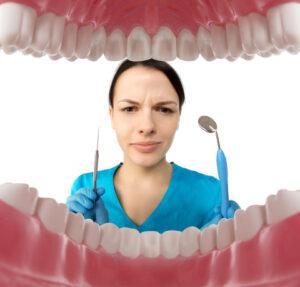Dental Crowns – Solution for a More Beautiful Smile
Nobody wants to be stuck with damaged or badly decaying teeth. Unfortunately, these concerns are not always avoided. The sugary nature of the American diet contributes to a high incidence of tooth decay. Even persons who wash and floss their teeth on a regular basis and attend every dental cleaning can occasionally encounter tooth damage.
When a tooth sustains severe damage, the dentist often recommends placing a crown. Dentists can place crowns on any tooth and manufacture them from several materials. Still, they all have one thing in common. All crowns act as caps for damaged teeth.
What Is a Dental Crown?
Most individuals want more information before seeing the dentist to get a crown placed. Dentists employ these devices to cover broken teeth, but what exactly are dental crowns and why do they need to be used?
Crowns are sometimes compared to tight hats for injured teeth. They are intended to restore the tooth’s form, size, look, and biting strength as well as prevent it from additional injury or decay.
Dental crowns come in a variety of styles. While most people leave the decision to their dentists, understanding the role that each form of crown plays in maintaining tooth function and oral health can be beneficial. Today’s dentistry patients can choose from the following crown types:
- Permanent crowns are fabricated in laboratories and designed to match the color and shape of the patient’s natural teeth.
- Temporary crowns are placed in a patient’s mouth while a laboratory fabricates the permanent crown.
- Same-day crowns can be designed and milled from ceramic in the office so the dentist can place them in one visit.
- Onlay or ¾ crowns cover only a portion of a damaged tooth.
Why Would Someone Need a Dental Crown?

Laboratories design dental crowns to restore damaged teeth to their original shape, size, and function. Any patient with one or more teeth that are decayed, fractured, extremely worn-down, poorly shaped, or severely discolored may be able to benefit from dental crowns. Dentists also use dental crowns to protect teeth after root canals, cover dental implants, and hold dental bridges in place.
From What Are Dental Crowns Made?
Ceramic is the material of choice for same-day and temporary crowns. Still, dentists can use permanent dental crowns from several types of materials. They include:
- Ceramic
- Porcelain
- Metal
- Zirconia
- Composite resin
Crowns can be composed of multiple materials, as well. For example, some patients have porcelain crowns that are fused to metal, to offer just one example.
Dentists have multiple factors to consider when choosing the suitable material for a patient’s crown. In terms of function, dentists must take the tooth’s location, its role, how much gum tissue surrounds it, and the amount of natural tooth remaining into account.
Aesthetically, dentists consider factors like how much the tooth shows when a patient smiles and what color the surrounding teeth are before recommending a material. But, of course, patients are also welcome to offer input.
How Long Do Dental Crowns Last?
 Dentists place temporary crowns using easily removable adhesives. The plan for temporary crowns is to last only long enough to fabricate a permanent crown. Permanent crowns usually last between 5 and 15 years. However, the expected lifespan of a dental crown will vary based on factors like placement, materials used in fabricating the crown, the patient’s diet, and mouth-related habits such as grinding teeth, clenching the jaw, biting fingernails, chewing ice, and using teeth to open packages.
Dentists place temporary crowns using easily removable adhesives. The plan for temporary crowns is to last only long enough to fabricate a permanent crown. Permanent crowns usually last between 5 and 15 years. However, the expected lifespan of a dental crown will vary based on factors like placement, materials used in fabricating the crown, the patient’s diet, and mouth-related habits such as grinding teeth, clenching the jaw, biting fingernails, chewing ice, and using teeth to open packages.
What Is the Procedure for Getting Dental Crowns?
Now that it’s clear what dental crowns are and how dentists use them, it’s time to discuss the dental crown procedure. The crown placement process varies slightly depending on the reason for placing it and whether patients are getting same-day crowns.
Since multi-visit procedures for placing permanent crowns remain more common than same-day crown placements, this more traditional method is suitable to start. During a conventional crown placement, the dentist will:
- Examine the tooth, which often involves taking X-rays or molds in advance.
- File down the tooth, removing part of its outer layer and, if necessary, any decayed tissue.
- Take an impression of the trimmed-down tooth and the surrounding area.
- Place a temporary crown over the affected tooth.
- Send the impression to a dental lab, where the permanent crown gets made.
- Remove the temporary crown and cement the permanent one during a second appointment, which the dentist typically schedules for several weeks after the first.
The procedure for placing same-day crowns is similar but shorter. It all takes place in one visit, where the dentist takes digital pictures and uses them to create the patient’s crown in the office. It usually takes two to four hours to complete the entire procedure.
Schedule a Consultation
Patients who think they could benefit from the placement of a dental crown should call to schedule consultations with their dentists. If someone is a good candidate, the dentist usually tries to schedule the patient for a consultation and exam as quickly as possible.
Brought To You By: https://www.simplysmilesdds.com/
The post What Patients Need To Know About Dental Crowns appeared first on https://arquiaca.org
The post What Patients Need To Know About Dental Crowns appeared first on https://wookicentral.com
The post What Patients Need To Know About Dental Crowns appeared first on https://gqcentral.co.uk

Comments are closed